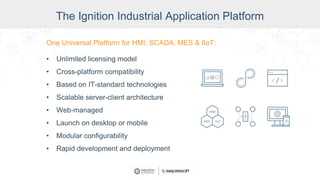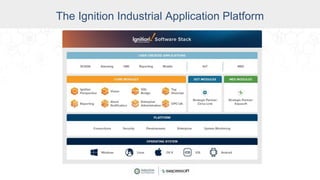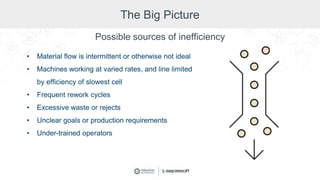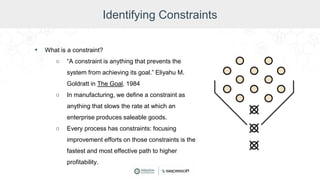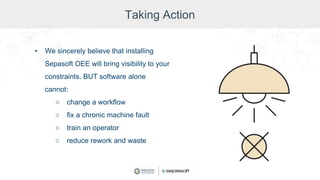Unlocking Greater Efficiency: The Why and How of OEE Implementation
- 2. Today’s Moderator Don Pearson Chief Strategy Officer Inductive Automation
- 3. Agenda • Introduction to Ignition and Sepasoft • Introduction to Today’s Speakers • Why Implement OEE? • The Big Picture • Identifying Constraints • Demo • Taking Action • Wrap-up Discussion and Audience Q&A
- 4. One Universal Platform for HMI, SCADA, MES & IIoT: • Unlimited licensing model • Cross-platform compatibility • Based on IT-standard technologies • Scalable server-client architecture • Web-managed • Launch on desktop or mobile • Modular configurability • Rapid development and deployment The Ignition Industrial Application Platform
- 5. The Ignition Industrial Application Platform
- 6. About Sepasoft • An Inductive Automation Strategic Third-Party Module Partner • Develops & supports MES Modules for Ignition • Incorporated in 2003 • Hundreds of companies in a variety of industries depend on Sepasoft MES software • 600+ MES implementations worldwide • 50+ MES-Certified System Integrator companies
- 7. Today’s Speakers Keith Adair MES Product Manager, Sepasoft Kevin McClusky Co-Director of Sales Engineering, Inductive Automation
- 8. OEE: Overall Equipment Effectiveness
- 9. Why Implement OEE? ● OEE is the product of the 3 key factors: ○ Availability: Line Uptime compared total time in Production ○ Performance: The rate at which the line starts pieces compared to the ideal rate ○ Quality: The ratio of good parts produced, compared to all parts started What is OEE? Availability OEE
- 10. Why Implement OEE? 1. Do you sell everything you produce? 2. Are orders always filled on time? 3. Do you know your top reasons for machine and line downtime? 4. Is overtime required to meet commitments? 5. Do you need to increase profit? 6. Do you need to improve your capacity? 7. Are you sitting on a lot of inventory? Will you benefit from OEE? A quiz:
- 11. Why Implement OEE? • What others have been able to achieve: ○ A major chemicals manufacturer was able to reduce its workweek from seven days to five ○ Swedish Match: “getting real-time information/visibility…”, “exceeded their expectations…”, “increased schedule rate by 12.5%” ○ Hunter Industries: “$300,000 in savings” in 2019 alone, “8% increase in OEE across all buildings”
- 12. Why Implement OEE? • What others have been able to achieve: ○ AriZona Beverages: empowered to “keep the 23-ounce can product at a $0.99 price point” ○ Daimler Trucks: empowered “to optimize operations” and “benchmark and compare production volumes… in real-time” ○ Samtec: “monitor rate of” gold consumption “on a daily basis by line, by part number and by operator...” and massively reduce gold usage.
- 13. The Big Picture • In a manufacturing plant, it’s easy to get bogged down in the details ○ Why is this work order late? ○ How long until this machine is back up? • In order to actually understand plant performance, you have to step back and see the “big picture.”
- 14. The Big Picture • Machine centers frequently blocked by downstream problems, or starved, waiting for raw materials • Unexpected shutdowns for inspections or safety reasons • Injuries • Machine faults • Over-complicated procedures Possible sources of inefficiency
- 15. The Big Picture • Material flow is intermittent or otherwise not ideal • Machines working at varied rates, and line limited by efficiency of slowest cell • Frequent rework cycles • Excessive waste or rejects • Unclear goals or production requirements • Under-trained operators Possible sources of inefficiency
- 16. Identifying Constraints • What is a constraint? ○ “A constraint is anything that prevents the system from achieving its goal.” Eliyahu M. Goldratt in The Goal, 1984 ○ In manufacturing, we define a constraint as anything that slows the rate at which an enterprise produces saleable goods. ○ Every process has constraints: focusing improvement efforts on those constraints is the fastest and most effective path to higher profitability.
- 17. Identifying Constraints • Many early attempts at understanding and dealing with constraints are scattershot and imperfect: ○ Manual data entry on paper, or in spreadsheets or on chalkboards ○ The original M.E.S. ■ Multiple Excel Spreadsheets ○ Winging it, using one’s “gut” to make choices, making self-interested decisions.
- 18. Identifying Constraints • Using automation as a tool to help identify constraints: ○ Accurate recording timing of downtime events to the second. ○ Many downtime causes can be recorded automatically ○ Make improvement decisions on automatically recorded facts ○ Minimizes time required by operators ○ Frequency of rework processes ○ Track production against scheduled targets in real time
- 19. Demo
- 20. Demo
- 21. Taking Action • We sincerely believe that installing Sepasoft OEE will bring visibility to your constraints. BUT software alone cannot: ○ change a workflow ○ fix a chronic machine fault ○ train an operator ○ reduce rework and waste
- 22. Taking Action: Who Should Be Involved? • For real change to occur, you need to build a team that includes all affected parties: ○ Operations ○ Maintenance ○ Management ○ Quality ○ IT ○ Others
- 23. Taking Action: The Process • That team should repeat something like the following process: ○ Meet regularly ○ Analyze data to identify and emphasize constraints - elevate the constraint ○ Identify anything that impedes smooth material flow throughout the plant ○ Find room for quick improvements – the low-hanging fruit ○ Carefully implement larger changes, measuring results as you progress ○ Repeat!
- 24. Taking Action: Best Practices and Keeping it Simple ● Have clearly defined criteria for success ● Include all applicable departments in the process ● Start small with a pilot on the most impactful line and don’t over-complicate, to rapidly identify ROI ● Use built-in functionality and ready-made components rather than complex, custom solutions where possible ● Track machine utilization, not just uptime and downtime: ○ Is equipment producing saleable product or inventory? ○ How long is equipment idle, or in changeover?
- 25. Wrapping Up The Discussion




